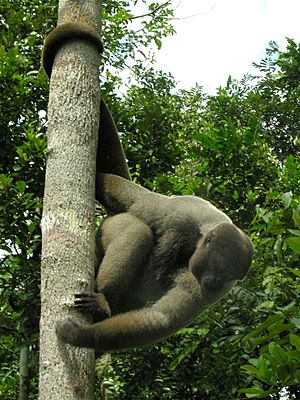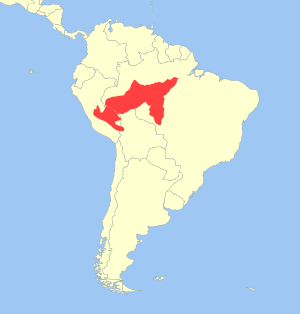Gray woolly monkey facts for kids
Quick facts for kids Gray woolly monkey |
|
|---|---|
 |
|
| Near the Tarumã Açu River, Brazil | |
| Conservation status | |
| Scientific classification |
|
| Kingdom: | Animalia |
| Phylum: | Chordata |
| Class: | Mammalia |
| Order: | Primates |
| Suborder: | Haplorhini |
| Infraorder: | Simiiformes |
| Family: | Atelidae |
| Genus: | Lagothrix |
| Species: | |
| Subspecies: |
L. l. cana
|
| Trinomial name | |
| Lagothrix lagothricha cana (É. Geoffroy, 1812)
|
|
 |
|
| Geographic range (includes L. l. tschudii) | |
| Synonyms | |
|
Lagothrix cana |
|
The gray woolly monkey (Lagothrix lagothricha cana) is a type of monkey found in South America. It lives in countries like Bolivia, Brazil, and Peru. This monkey gets its name from its thick, soft gray fur. Its hands, feet, face, and the inside of its arms are usually dark.
Sadly, the gray woolly monkey has been considered an endangered animal since 2008. This means its numbers have dropped a lot. Over the last 45 years, its population has gone down by half. This is mainly because of deforestation (forests being cut down) and hunting.
Contents
About the Gray Woolly Monkey
What is a Subspecies?
The gray woolly monkey is a subspecies of the common woolly monkey. Think of a subspecies as a special group within a species. They are very similar but have small differences, often because they live in different places. Scientists sometimes change how they classify animals as they learn more.
Where Gray Woolly Monkeys Live
Their Forest Home
Gray woolly monkeys mostly live in cloud forests. These are special forests that are often covered by clouds or fog. They can be found high up in the mountains, usually between 1,000 and 2,500 meters above sea level. Some have even been seen as low as 700 meters in Bolivia.
Life in the Treetops
These monkeys spend most of their time high in the trees. They look for food and travel through the forest canopy. They use their long, strong tails to help them move. Their tails are "prehensile," which means they can grip things like another hand. They can even hang from their tails! This helps them swing between trees.
What Gray Woolly Monkeys Eat
Their Favorite Foods
Gray woolly monkeys mainly eat fruit. They love to find ripe fruits in the forest. If fruit is hard to find, they will also eat young leaves. Sometimes, they might even eat seeds.
How Gray Woolly Monkeys Live Together
Monkey Groups
Gray woolly monkeys live in groups. These groups usually have between 11 and 25 monkeys. The groups include monkeys of all ages and both males and females. They tend to stick together as they move through the forest. They are quite friendly with other groups of woolly monkeys. They will often share good feeding spots without fighting.
Size of Gray Woolly Monkeys
How Big Are They?
Male gray woolly monkeys are generally bigger than females.
- A male's body (from head to bottom) is about 46 to 65 centimeters long.
- A female's body is about 46 to 58 centimeters long.
- Their tails are very long, usually around 66 to 68 centimeters.
How Much Do They Weigh?
- Male gray woolly monkeys weigh about 9.5 kilograms on average.
- Female gray woolly monkeys weigh about 7.7 kilograms on average.
Threats to Gray Woolly Monkeys
Why Their Numbers Are Shrinking
The biggest danger to gray woolly monkeys is hunting. People hunt them for food. They are also caught to be sold as pets. Hunters often target female monkeys. They shoot the mother and then take her baby to sell. There's a sad story from the Amazon where hunters killed over 200 woolly monkeys in less than two years. This caused the monkeys to disappear from that area.
Another major threat is deforestation. This is when forests are cut down for farms, logging, or other uses. This destroys the monkeys' homes. Mining for a mineral called cassiterite (used to make tin) also harms them. It destroys their habitat and can lead to more hunting.
Protecting Gray Woolly Monkeys
Conservation Efforts
Many people are working to protect the gray woolly monkey. They are safe in many national parks and protected areas. They are also listed in Appendix II of the Convention on International Trade of Endangered Species (CITES). This means that trading them across borders is controlled to help protect them.
Protected Areas in Brazil
Here are some of the protected places in Brazil where gray woolly monkeys live or might live:
- Amazonia National Park
- Mapinguari National Park
- Abufari Biological Reserve
- Jaru Biological Reserve
- Iquê Ecological Station
- Rio Acre Ecological Station
- Cuniã Ecological Station
- Jatuarana National Forest
- Macauá National Forest
- São Francisco National Forest
- Santa Rosa do Purus National Forest
- Humaita National Forest
- Jamari National Forest
- Bom Futuro National Forest
- Purus National Forest
- Mapiá-Inauini National Forest
- Pau Rosa National Forest
- Tefe National Forest
Protected Areas in Bolivia
In Bolivia, all known gray woolly monkeys live in two main protected areas:
- Apolobamba Natural Area of Integrated Management
- Madidi National Park and Natural Area of Integrated Management
See also
 In Spanish: Mono lanudo gris para niños
In Spanish: Mono lanudo gris para niños


